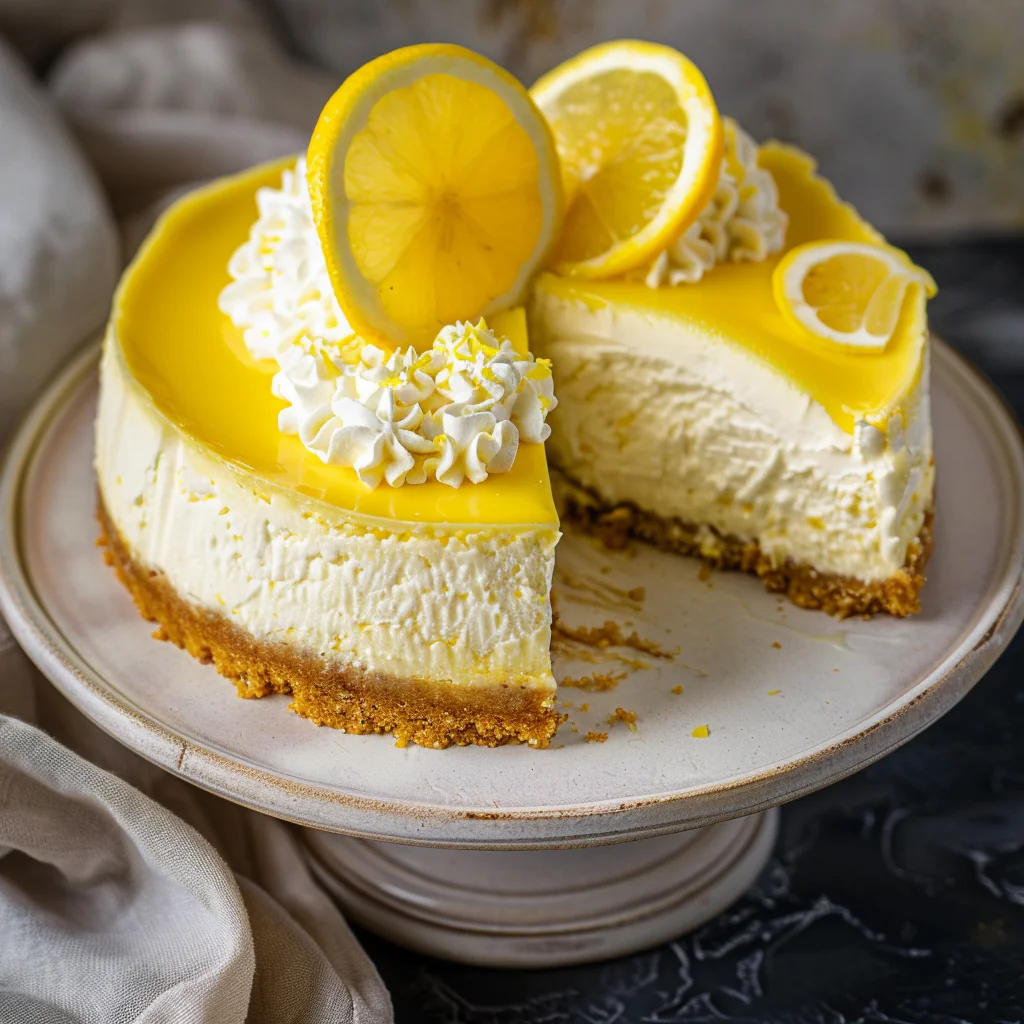Introduction
Lemon cheesecake combines the creamy richness of traditional cheesecake with the bright, zesty flavor of fresh lemons. It’s a dessert that manages to be both indulgent and refreshing, making it a perfect choice for gatherings, celebrations, or simply satisfying your sweet tooth at home.
The smooth, velvety filling is balanced beautifully by a crumbly, buttery crust, creating a delightful texture in every bite. Whether you're a seasoned baker or just starting in the kitchen, this lemon cheesecake recipe is approachable and rewarding.
Let’s dive into the ingredients and preparation, ensuring you can create this scrumptious dessert with confidence.
Ingredients
- 200 g digestive biscuits, crushed
- 100 g unsalted butter, melted
- 600 g cream cheese, softened
- 200 g granulated sugar
- 150 ml sour cream
- 100 ml lemon juice (freshly squeezed)
- 1 tablespoon lemon zest
- 1 teaspoon vanilla extract
- 3 large eggs
Directions & Preparation
- Preheat your oven to 160°C (320°F). Prepare a 9-inch springform pan by greasing it lightly and wrapping the outside with aluminum foil to prevent water from seeping in during baking.
- In a medium bowl, combine the crushed digestive biscuits and melted butter. Mix until the crumbs are evenly coated and resemble wet sand.
- Press the biscuit mixture firmly into the bottom of the prepared springform pan to create an even layer. Use the back of a measuring cup or your hands to ensure it's compact.
- In a large mixing bowl, beat the softened cream cheese with an electric mixer until smooth and creamy, about 2-3 minutes. Scrape down the sides of the bowl as needed.
- Add the granulated sugar, sour cream, lemon juice, lemon zest, and vanilla extract to the cream cheese. Beat until fully combined, ensuring no lumps remain in the mixture.
- Add the eggs one at a time, mixing on low speed after each addition just until incorporated. Be careful not to overmix, as this can introduce air bubbles that may cause cracking.
- Pour the cheesecake filling over the prepared crust in the springform pan, smoothing out the top with a spatula.
- Place the springform pan into a larger baking dish and fill the dish with hot water until it reaches halfway up the sides of the springform pan. This water bath helps to regulate the temperature while baking.
- Bake in the preheated oven for 50-60 minutes, or until the edges are set but the center is still slightly jiggly. Turn off the oven and crack the door, allowing the cheesecake to cool slowly for about an hour.
- Remove the cheesecake from the oven and the water bath. Let it cool to room temperature before transferring it to the refrigerator. Chill for at least 4 hours, preferably overnight, to allow the flavors to meld and the texture to set.
- Once chilled, carefully remove the sides of the springform pan. Slice and serve your lemon cheesecake as is or with a dollop of whipped cream or a raspberry sauce for added flair.

FAQs
What can I do if my cheesecake is too soft after baking?
If your cheesecake is too soft, it may need more time in the oven. Try baking it a little longer, checking every 5 minutes until the edges are set. Additionally, ensure that you let it cool in the oven with the door ajar to help firm it up.
Can I use bottled lemon juice instead of fresh?
While fresh lemon juice offers the best flavor, bottled lemon juice can be used in a pinch. Just be aware that the taste may not be as vibrant.
Why does my cheesecake have cracks on top?
Cracks often occur due to overmixing or baking at too high a temperature. To prevent this, mix the ingredients just until combined and bake at a moderate temperature with a water bath.
How can I make the cheesecake less sweet?
To reduce the sweetness, you can decrease the amount of sugar in the filling. Start by reducing it by 50 grams and taste the mixture before adding more.
What should I do if my crust is too crumbly?
If your crust is crumbly, you may need to add more melted butter to help bind the crumbs together. Start with an additional tablespoon and mix again.
Is there a way to add more lemon flavor to the cheesecake?
You can enhance the lemon flavor by increasing the amount of lemon juice and zest. Just be careful not to add too much liquid, which might affect the texture.
Can I scale this recipe for a smaller or larger pan?
Yes, you can scale the recipe. For a smaller pan, reduce the ingredients by half; for a larger pan, increase them by about 1.5 times. Adjust baking times accordingly.
Conclusion
Creating a lemon cheesecake at home is a rewarding experience that brings a touch of elegance to any dessert table. The refreshing citrus notes make it a delightful choice for warm days, while its creamy texture delights any palate.
With the right ingredients and a little patience, you can master this recipe and impress your family and friends. Enjoy your baking journey and the delicious results that follow!
Recipe Card
Delightful Lemon Cheesecake for Every Occasion
Ingredients
- 200 g digestive biscuits crushed
- 100 g unsalted butter melted
- 600 g cream cheese softened
- 200 g granulated sugar
- 150 ml sour cream
- 100 ml lemon juice freshly squeezed
- 1 tablespoon lemon zest
- 1 teaspoon vanilla extract
- 3 large eggs
Instructions
- Preheat your oven to 160°C (320°F). Prepare a 9-inch springform pan by greasing it lightly and wrapping the outside with aluminum foil to prevent water from seeping in during baking.
- In a medium bowl, combine the crushed digestive biscuits and melted butter. Mix until the crumbs are evenly coated and resemble wet sand.
- Press the biscuit mixture firmly into the bottom of the prepared springform pan to create an even layer. Use the back of a measuring cup or your hands to ensure it's compact.
- In a large mixing bowl, beat the softened cream cheese with an electric mixer until smooth and creamy, about 2-3 minutes. Scrape down the sides of the bowl as needed.
- Add the granulated sugar, sour cream, lemon juice, lemon zest, and vanilla extract to the cream cheese. Beat until fully combined, ensuring no lumps remain in the mixture.
- Add the eggs one at a time, mixing on low speed after each addition just until incorporated. Be careful not to overmix, as this can introduce air bubbles that may cause cracking.
- Pour the cheesecake filling over the prepared crust in the springform pan, smoothing out the top with a spatula.
- Place the springform pan into a larger baking dish and fill the dish with hot water until it reaches halfway up the sides of the springform pan. This water bath helps to regulate the temperature while baking.
- Bake in the preheated oven for 50-60 minutes, or until the edges are set but the center is still slightly jiggly. Turn off the oven and crack the door, allowing the cheesecake to cool slowly for about an hour.
- Remove the cheesecake from the oven and the water bath. Let it cool to room temperature before transferring it to the refrigerator. Chill for at least 4 hours, preferably overnight, to allow the flavors to meld and the texture to set.
- Once chilled, carefully remove the sides of the springform pan. Slice and serve your lemon cheesecake as is or with a dollop of whipped cream or a raspberry sauce for added flair.
Notes
Additional serving suggestions: pair with a crisp salad, garlic bread, or roasted seasonal vegetables for balance.
For make-ahead, prep components separately and assemble just before heating to preserve texture.
Taste and adjust with acid (lemon/vinegar) and salt right at the end to wake up flavors.

